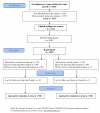No reduction in instrumental vaginal births and no increased risk for adverse perineal outcome in nulliparous women giving birth on a birth seat: results of a Swedish randomized controlled trial
- PMID: 21435238
- PMCID: PMC3071335
- DOI: 10.1186/1471-2393-11-22
No reduction in instrumental vaginal births and no increased risk for adverse perineal outcome in nulliparous women giving birth on a birth seat: results of a Swedish randomized controlled trial
Abstract
Background: The WHO advises against recumbent or supine position for longer periods during labour and birth and states that caregivers should encourage and support the woman to take the position in which she feels most comfortable. It has been suggested that upright positions may improve childbirth outcomes and reduce the risk for instrumental delivery; however RCTs of interventions to encourage upright positions are scarce. The aim of this study was to test, by means of a randomized controlled trial, the hypothesis that the use of a birthing seat during the second stage of labor, for healthy nulliparous women, decreases the number of instrumentally assisted births and may thus counterbalance any increase in perineal trauma and blood loss.
Methods: A randomized controlled trial in Sweden where 1002 women were randomized to birth on a birth seat (experimental group) or birth in any other position (control group). Data were collected between November 2006 and July 2009. The primary outcome measurement was the number of instrumental deliveries. Secondary outcome measurements included perineal lacerations, perineal edema, maternal blood loss and hemoglobin. Analysis was by intention to treat.
Results: The main findings of this study were that birth on the birth seat did not reduce the number of instrumental vaginal births, there was an increase in blood loss between 500 ml and 1000 ml in women who gave birth on the seat but no increase in bleeding over 1000 ml and no increase in perineal lacerations or perineal edema.
Conclusions: The birth seat did not reduce the number of instrumental vaginal births. The study confirmed an increased blood loss 500 ml - 1000 ml but not over 1000 ml for women giving birth on the seat. Giving birth on a birth seat caused no adverse consequences for perineal outcomes and may even be protective against episiotomies.
Trial registration: ClinicalTrials.gov NCT01182038.
Similar articles
-
Striving for scientific stringency: a re-analysis of a randomised controlled trial considering first-time mothers' obstetric outcomes in relation to birth position.BMC Pregnancy Childbirth. 2012 Nov 22;12:135. doi: 10.1186/1471-2393-12-135. BMC Pregnancy Childbirth. 2012. PMID: 23173988 Free PMC article. Clinical Trial.
-
Maternal position in the second stage of labour for women with epidural anaesthesia.Cochrane Database Syst Rev. 2018 Nov 9;11(11):CD008070. doi: 10.1002/14651858.CD008070.pub4. Cochrane Database Syst Rev. 2018. PMID: 30411804 Free PMC article.
-
[Fetal expulsion: Which interventions for perineal prevention? CNGOF Perineal Prevention and Protection in Obstetrics Guidelines].Gynecol Obstet Fertil Senol. 2018 Dec;46(12):937-947. doi: 10.1016/j.gofs.2018.10.029. Epub 2018 Oct 28. Gynecol Obstet Fertil Senol. 2018. PMID: 30377094 French.
-
Duration of second stage of labor and instrumental delivery as risk factors for severe perineal lacerations: population-based study.BMC Pregnancy Childbirth. 2017 Feb 21;17(1):72. doi: 10.1186/s12884-017-1251-6. BMC Pregnancy Childbirth. 2017. PMID: 28222704 Free PMC article.
-
Preventing perineal trauma during childbirth: a systematic review.Obstet Gynecol. 2000 Mar;95(3):464-71. doi: 10.1016/s0029-7844(99)00560-8. Obstet Gynecol. 2000. PMID: 10711565
Cited by
-
Position in the second stage of labour for women without epidural anaesthesia.Cochrane Database Syst Rev. 2017 May 25;5(5):CD002006. doi: 10.1002/14651858.CD002006.pub4. Cochrane Database Syst Rev. 2017. PMID: 28539008 Free PMC article.
-
Striving for scientific stringency: a re-analysis of a randomised controlled trial considering first-time mothers' obstetric outcomes in relation to birth position.BMC Pregnancy Childbirth. 2012 Nov 22;12:135. doi: 10.1186/1471-2393-12-135. BMC Pregnancy Childbirth. 2012. PMID: 23173988 Free PMC article. Clinical Trial.
-
Effects of Using Sitting Position versus Lithotomy Position during the Second Stage of Labour on Maternal and Neonatal Outcomes and the Childbirth Experience of Chinese Women: A Prospective Cohort Study.Healthcare (Basel). 2023 Nov 20;11(22):2996. doi: 10.3390/healthcare11222996. Healthcare (Basel). 2023. PMID: 37998488 Free PMC article.
-
Maternal position in the second stage of labour for women with epidural anaesthesia.Cochrane Database Syst Rev. 2018 Nov 9;11(11):CD008070. doi: 10.1002/14651858.CD008070.pub4. Cochrane Database Syst Rev. 2018. PMID: 30411804 Free PMC article.
-
Birth position and obstetric anal sphincter injury: a population-based study of 113 000 spontaneous births.BMC Pregnancy Childbirth. 2015 Oct 9;15:252. doi: 10.1186/s12884-015-0689-7. BMC Pregnancy Childbirth. 2015. PMID: 26453177 Free PMC article.
References
-
- Lavender T, Mlay R. The WHO Reproductive Health Library. Geneva: World Health Organization; 2006. Position in the second stage of labour for women without epidural anaesthesia: RHL commentary.
-
- Sandin-Bojö AK, Kvist LJ. Care in Labor: A Swedish Survey Using the Bologna Score. Birth. 2008;35:4. - PubMed
-
- Roberts J, Hanson L. Best Practices in Second Stage Labor Care: maternal Bearing Down and Positioning. Journal of Midwifery & Women's Health. 2007;52(3):238–245. - PubMed
Publication types
MeSH terms
Associated data
LinkOut - more resources
Full Text Sources
Medical


